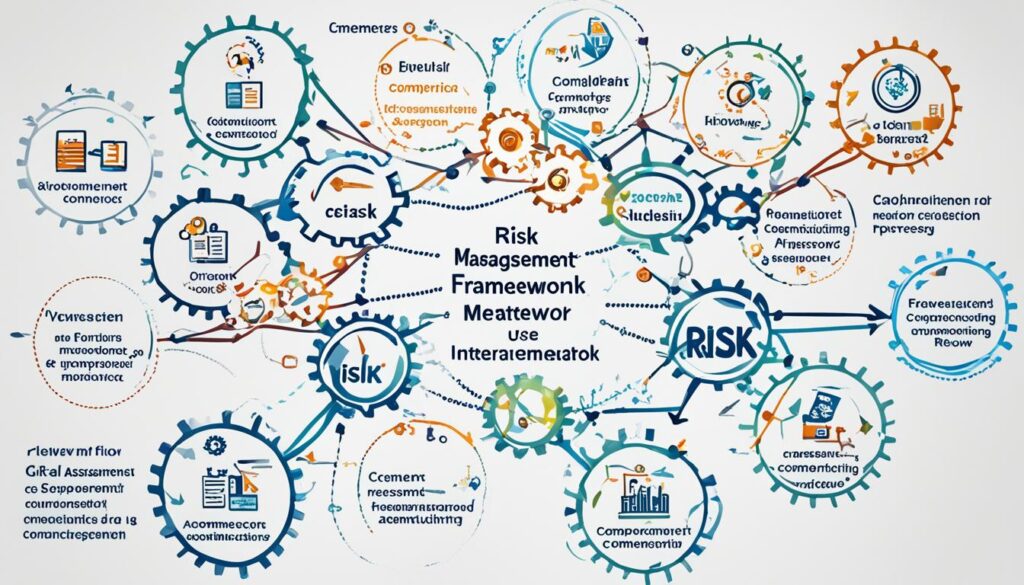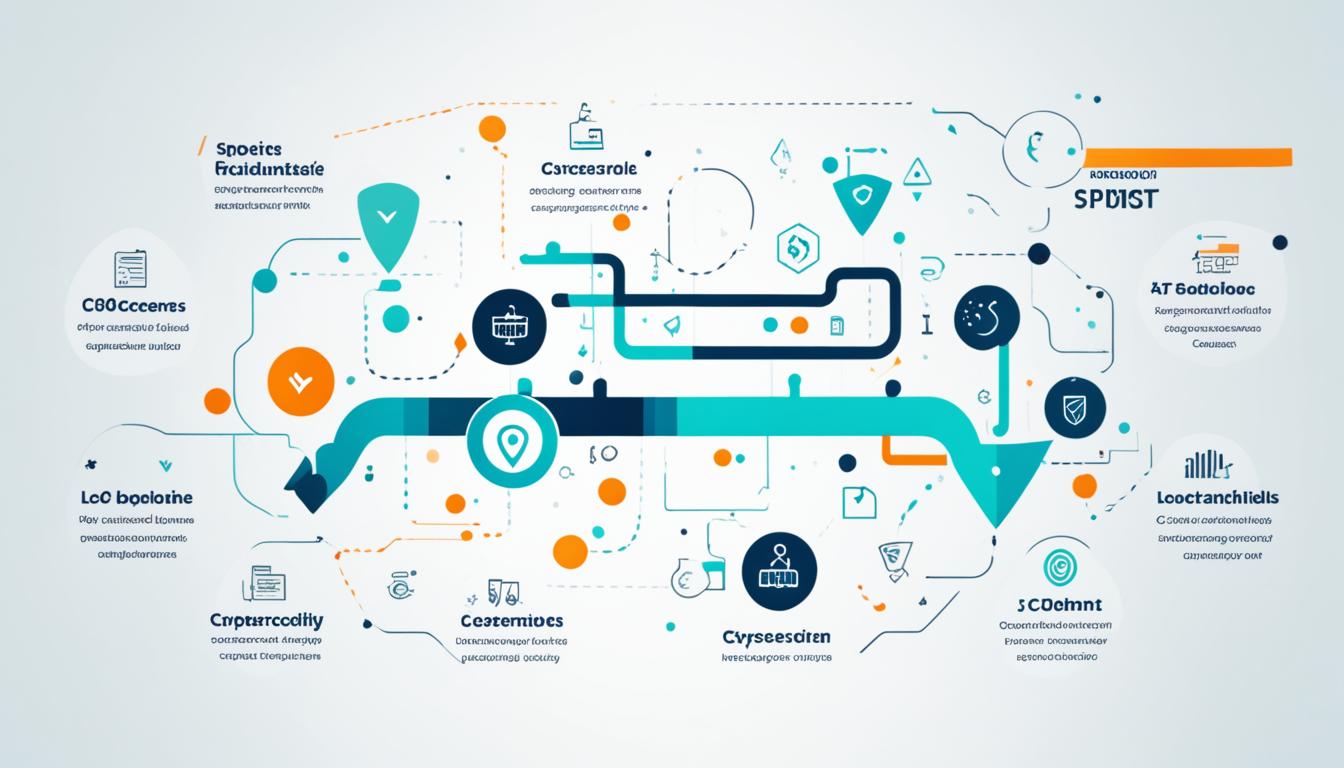As small enterprise owners, we understand the importance of cybersecurity in protecting our businesses from ever-evolving threats. Implementing an effective cybersecurity strategy is crucial, but where do we start? That’s where the NIST SP800-37 comes in. This guide, initially developed for federal agencies, provides a comprehensive framework for managing cyber risks and enhancing our enterprise security. In this article, we will demystify the SP800-37 framework and provide you with actionable insights on how to leverage its guidelines for your small business’s cybersecurity needs.
What is the NIST Risk Management Framework?
The NIST Risk Management Framework (RMF) is a set of policies and standards that help organizations manage and mitigate risks to their information systems. It provides a structured approach to identifying, assessing, and implementing security controls to protect our assets and sensitive data. While initially designed for federal agencies, the RMF can be adapted for use by small enterprise owners to enhance our cybersecurity posture. Understanding the key components of the framework and how to apply them is essential for strengthening our cyber defense strategy.
Key Steps in the NIST Risk Management Framework
The NIST Risk Management Framework involves several key steps that small enterprise owners can follow to enhance their cybersecurity posture. These steps include:
- 1. Initiate the risk management process by establishing the scope and objectives.
- 2. Conduct a thorough risk assessment to identify and prioritize potential threats and vulnerabilities.
- 3. Select and implement appropriate security controls to mitigate identified risks.
- 4. Continuously monitor and assess the effectiveness of implemented controls.
- 5. Respond to and recover from security incidents and ensure lessons learned are incorporated into future risk management efforts.
Benefits of Using the NIST Risk Management Framework
Implementing the NIST Risk Management Framework offers several benefits for small enterprise owners, including:
- Effective identification and management of cybersecurity risks.
- Compliance with industry standards and regulatory requirements.
- Improved overall security posture and protection of sensitive data.
- Enhanced resilience in the face of evolving cyber threats.
- Greater confidence and trust from customers and business partners.
Getting Started with the NIST Risk Management Framework
Getting started with the NIST Risk Management Framework may seem overwhelming, especially for small enterprise owners with limited experience in information security. Here are some tips to help you begin:
- 1. Familiarize yourself with the NIST SP800-37 guide and its key principles.
- 2. Assess your business’s current cybersecurity posture and identify areas for improvement.
- 3. Determine the scope and objectives of your risk management efforts.
- 4. Seek external support from cybersecurity experts or consultants if needed.
- 5. Develop a roadmap for implementing the framework and prioritize actions based on risk assessment findings.
The NIST Cybersecurity Framework for Small Businesses
The NIST Cybersecurity Framework offers small businesses a comprehensive approach to managing cybersecurity risks. This framework consists of three main components: the Core, the Profiles, and the Implementation Tiers. By leveraging these components, small enterprise owners can tailor their cybersecurity strategies to align with their unique needs and risk profiles.
Key Considerations in Applying the NIST Risk Management Framework
When applying the NIST Risk Management Framework to small enterprises, several key considerations should be taken into account:
- 1. The scalability and adaptability of cybersecurity controls.
- 2. The integration of risk management into business processes.
- 3. The allocation of cybersecurity resources and budget.
- 4. The involvement of stakeholders and employees in the risk management process.
- 5. The alignment of cybersecurity efforts with business objectives and industry-specific regulations.
Overcoming Challenges in Implementing the NIST Risk Management Framework
Implementing the NIST Risk Management Framework can present challenges for small enterprise owners. Some common challenges include:
- 1. Limited budget and resources for cybersecurity initiatives.
- 2. Lack of cybersecurity expertise and knowledge within the organization.
- 3. Resistance to change or lack of buy-in from employees.
- 4. Complex regulatory requirements and compliance obligations.
- 5. Rapidly evolving cyber threat landscape.
Resources and Support for Small Enterprise Owners Implementing the NIST Risk Management Framework
Small enterprise owners have access to various resources and support to aid them in implementing the NIST Risk Management Framework:
- 1. NIST publications and guidelines, including the SP800-37 guide.
- 2. Online training courses and certifications in cybersecurity and risk management.
- 3. Industry-specific forums and communities for knowledge sharing and best practices.
- 4. Cybersecurity consulting services or managed security service providers.
- 5. Collaboration with other small business owners facing similar cybersecurity challenges.
Realizing the Benefits of the NIST Risk Management Framework for Small Enterprise Owners
Implementing the NIST Risk Management Framework can bring several benefits to small enterprise owners:
- 1. Strengthened cybersecurity defenses and reduced vulnerability to cyber threats.
- 2. Enhanced trust and credibility among customers and business partners.
- 3. Improved compliance with industry regulations and contractual obligations.
- 4. Cost savings through proactive risk management and incident response.
- 5. Better resilience and ability to recover from security incidents.
Case Studies: Successful Implementation of the NIST Risk Management Framework by Small Enterprise Owners
Several small enterprise owners have successfully implemented the NIST Risk Management Framework to enhance their cybersecurity resilience. These case studies highlight their accomplishments and provide insights into effective implementation strategies:
Conclusion
The NIST Risk Management Framework provides a valuable guide for small enterprise owners looking to enhance their cybersecurity posture. By following the framework’s principles and guidelines, small businesses can prioritize risk management efforts, implement effective security controls, and continuously monitor for threats and vulnerabilities. While the implementation may present challenges, leveraging available resources, seeking external support, and customizing the framework to fit the business’s unique needs can lead to successful implementation. By embracing the NIST Risk Management Framework, small enterprise owners can proactively protect their operations, assets, and sensitive data from cyber threats.
What is the NIST Risk Management Framework?
The NIST Risk Management Framework (RMF) is a comprehensive set of policies and standards designed to assist organizations in managing and mitigating risks to their information systems. This framework provides a structured approach to identify, assess, and implement security controls, ensuring the protection of valuable assets and sensitive data. While initially intended for federal agencies, the RMF can be tailored to suit the needs of small enterprise owners, empowering them to strengthen their cybersecurity posture.
The key components of the NIST RMF include:
- Risk Assessment: Conducting a thorough evaluation of potential risks and vulnerabilities to identify areas of concern.
- Security Controls: Implementing appropriate security measures to mitigate identified risks and protect data integrity.
- Security Control Assessment: Evaluating the effectiveness of implemented security controls to ensure they meet desired objectives.
- Risk Mitigation: Developing strategies and action plans to address identified risks and minimize their impact.
- Continuous Monitoring: Ongoing monitoring, analysis, and remediation of risks and vulnerabilities, allowing for proactive risk management.
By understanding and applying the NIST Risk Management Framework, small enterprise owners can establish a robust cybersecurity strategy, aligning with industry best practices and promoting a proactive approach to risk management. This framework empowers small businesses to enhance their security posture, safeguard sensitive information, and ensure business continuity.
Key Steps in the NIST Risk Management Framework
The NIST Risk Management Framework provides small enterprise owners with a systematic approach to managing cybersecurity risks and implementing effective security controls. By following the key steps outlined in the framework, businesses can enhance their cybersecurity posture and protect their sensitive data. Here are the essential steps in the NIST Risk Management Framework:
- Risk Assessment: Begin by conducting a comprehensive risk assessment to identify potential threats, vulnerabilities, and impacts to your information systems. This assessment will help you prioritize your cybersecurity efforts and focus on the most critical areas.
- Security Control Selection: Based on the results of the risk assessment, select appropriate security controls to mitigate the identified risks. These controls should align with your organization’s goals, objectives, and risk tolerance level.
- Control Implementation: Implement the selected security controls within your information systems. This process involves integrating the controls into your existing infrastructure and ensuring their proper configuration and functionality.
- Control Assessment: Evaluate the effectiveness of the implemented security controls through regular assessments and audits. This step helps you identify any weaknesses or vulnerabilities that may exist and enables you to take corrective action.
- Authorization: Obtain authorization to operate your information systems based on the assessment of security controls. This authorization ensures that your systems meet the required security standards and can be used to support critical business operations.
- Continuous Monitoring: Continuously monitor your information systems to detect and respond to any new threats or vulnerabilities. Regularly review and update your security controls to address emerging risks and maintain a strong cybersecurity posture.
By following these key steps in the NIST Risk Management Framework, small enterprise owners can implement effective cybersecurity measures and protect their valuable assets and data from cyber threats. It is essential to approach risk management and security control implementation as an ongoing process to stay ahead of evolving cyber risks in today’s digital landscape.
Benefits of Using the NIST Risk Management Framework
Implementing the NIST Risk Management Framework offers several benefits for small enterprise owners.
- Enhanced Cybersecurity: The NIST Risk Management Framework provides a comprehensive approach to cybersecurity, helping small businesses identify and mitigate risks effectively. By implementing the framework’s guidelines and best practices, small enterprise owners can strengthen their cyber defense strategies and protect their valuable assets and sensitive data.
- Compliance with Regulations: Small businesses often face regulatory requirements related to cybersecurity. The NIST Risk Management Framework helps small enterprises align with these regulations by providing a structured approach to risk management and compliance. By implementing the framework, business owners can demonstrate their commitment to cybersecurity and meet the necessary compliance standards.
- Improved Risk Management: Establishing a robust risk management process is crucial for small businesses to identify, assess, and mitigate potential threats. The NIST Risk Management Framework assists small enterprises in developing an effective risk management strategy by outlining clear steps and guidelines. This framework enables businesses to proactively manage risks and minimize the impact of cybersecurity incidents.
- Cybersecurity Best Practices: The NIST Risk Management Framework incorporates industry best practices for cybersecurity. By following the framework, small business owners can leverage proven techniques and methodologies to strengthen their security controls, implement incident response plans, and address emerging cyber threats effectively.
To visualize the benefits of using the NIST Risk Management Framework, refer to the table below:
| Benefits | Description |
|---|---|
| Enhanced Cybersecurity | Implementing the NIST Risk Management Framework helps small businesses strengthen their cyber defense strategies and protect their valuable assets and sensitive data. |
| Compliance with Regulations | The NIST Risk Management Framework assists small enterprises in meeting regulatory requirements by providing a structured approach to risk management and compliance. |
| Improved Risk Management | Small businesses can establish effective risk management strategies by following the clear steps and guidelines outlined in the NIST Risk Management Framework. |
| Cybersecurity Best Practices | The NIST Risk Management Framework incorporates industry best practices, enabling small business owners to strengthen their security controls and address emerging cyber threats. |
Getting Started with the NIST Risk Management Framework

Implementing the NIST Risk Management Framework may seem like a daunting task, particularly for small enterprise owners who have limited experience in information security. However, with the right approach and guidance, you can successfully navigate the implementation process and enhance your cybersecurity posture. Here are some tips to help you get started:
- Educate Yourself: Begin by familiarizing yourself with the NIST Risk Management Framework and its key principles. Understand the importance of risk assessment, security controls, and implementation in mitigating cyber threats.
- Identify Your Assets: Conduct a thorough inventory of your organization’s assets, including hardware, software, and sensitive data. This will help you prioritize your security efforts and allocate resources effectively.
- Conduct a Risk Assessment: Assess the potential risks and vulnerabilities that your organization faces. Identify the impact and likelihood of each risk and prioritize them based on their potential impact on your operations.
- Select Appropriate Security Controls: Refer to the NIST Special Publication 800-53 for a comprehensive list of security controls that you can implement. Choose controls that are relevant to your organization’s needs and align with industry best practices.
- Develop an Implementation Plan: Create a detailed plan that outlines the steps, timelines, and responsibilities for implementing the selected security controls. This plan should consider the unique characteristics and requirements of your organization.
- Train and Engage Your Team: Ensure that your employees have the necessary knowledge and skills to support the implementation of the security controls. Foster a culture of cybersecurity awareness and involve all team members in the process.
- Monitor and Review: Regularly monitor the effectiveness of your implemented security controls and review your risk management activities. Stay updated with the latest cybersecurity trends and adjust your strategy accordingly.
By following these tips, you can establish a solid foundation for implementing the NIST Risk Management Framework and enhancing your small enterprise’s cybersecurity defenses. Remember, cybersecurity is an ongoing process, and continuous improvement is crucial to staying resilient against evolving threats.
Note: The NIST Risk Management Framework provides a comprehensive approach to managing cybersecurity risks. By following its guidelines, small enterprise owners can effectively assess and mitigate risks, strengthen security controls, and safeguard their organization’s assets and sensitive information.
The NIST Cybersecurity Framework for Small Businesses
As small businesses face an ever-increasing number of cyber threats, it is crucial to have a robust cybersecurity strategy in place. The NIST Cybersecurity Framework provides a valuable framework for small businesses to manage and mitigate these risks effectively. Consisting of three main components – the Core, the Profiles, and the Implementation Tiers – this framework offers a comprehensive approach to cybersecurity.
The Core of the NIST Cybersecurity Framework encompasses five key functions: Identify, Protect, Detect, Respond, and Recover. By aligning their cybersecurity practices with these functions, small businesses can create a solid foundation for addressing potential vulnerabilities and protecting sensitive information.
The Profiles component allows small businesses to customize the framework according to their unique needs and risk tolerance. By creating a profile, organizations can prioritize and tailor their cybersecurity efforts to address their most critical threats and vulnerabilities.
Moreover, the Implementation Tiers provide a roadmap for organizations to assess their current cybersecurity capabilities and set future goals. These tiers range from Tier 1 (Partial) to Tier 4 (Adaptive), allowing businesses to gauge their cybersecurity maturity and progress towards more advanced levels of protection.
Incorporating the NIST Cybersecurity Framework into small business operations brings several benefits. It promotes the adoption of cybersecurity best practices, enhances risk management capabilities, and helps organizations stay compliant with industry regulations. By implementing this framework, small businesses can safeguard their valuable assets, defend against cyber threats, and maintain the trust of their customers.
| NIST Cybersecurity Framework Components | Description |
|---|---|
| The Core | The foundation of the framework, consisting of five functions: Identify, Protect, Detect, Respond, and Recover. |
| The Profiles | A customizable component that allows organizations to tailor the framework to their specific needs and risk tolerance. |
| The Implementation Tiers | Provides a roadmap for organizations to assess their current cybersecurity capabilities and set goals for improvement. |
Key Considerations in Applying the NIST Risk Management Framework

Implementing the NIST Risk Management Framework requires several key considerations for small enterprise owners. By addressing these considerations, businesses can enhance their cybersecurity posture and effectively manage risks. Here are some important factors to keep in mind:
Adequate Resource Allocation:
Ensure that sufficient resources, both in terms of personnel and budget, are allocated to support the implementation of the NIST Risk Management Framework. This includes dedicated cybersecurity professionals or partnering with external experts to facilitate the process.
Customization for Small Enterprises:
Adapt the NIST Risk Management Framework to align with the specific needs and capabilities of your small enterprise. Tailoring the framework will ensure that it is applicable and feasible within your organization’s structure, size, and industry sector.
Identification of Critical Assets:
Thoroughly identify and categorize the critical assets within your organization. This includes hardware, software, data, systems, and facilities that are essential for your business operations. Prioritizing the protection of these assets will help focus your cybersecurity efforts.
Compliance with Regulations:
Stay updated on industry-specific regulations and legal requirements that may impact your small enterprise. Ensure that your implementation of the NIST Risk Management Framework aligns with these regulations and helps your business maintain compliance.
Cybersecurity Training and Awareness:
Invest in regular cybersecurity training and awareness programs for your employees. Educating your staff about the importance of cybersecurity and their role in protecting the organization’s assets will strengthen your defense against cyber threats.
Ongoing Monitoring and Assessment:
Implement a robust monitoring and assessment process to continuously identify and mitigate risks. Regularly review and update your cybersecurity controls, policies, and procedures to address emerging threats and vulnerabilities.
Continual Improvement:
Adopt a culture of continual improvement when it comes to cybersecurity. Encourage feedback from employees, perform regular risk assessments, and leverage best practices to enhance your risk management practices over time.
Collaboration and Information Sharing:
Engage in collaborative efforts with other small enterprises, industry associations, and government agencies to share insights and resources. Collaboration can help small enterprise owners gain valuable knowledge and support in implementing the NIST Risk Management Framework effectively.
By considering these key factors, small enterprise owners can maximize the benefits of implementing the NIST Risk Management Framework and strengthen their cybersecurity defenses.
| Framework | Applicability | Key Features |
|---|---|---|
| NIST Risk Management Framework | Wide range of organizations including small enterprises | – Security life cycle approach – Iterative risk management process – Focus on continuous monitoring and assessment |
| NIST Cybersecurity Framework | General applicability for all types of organizations | – Five core functions: Identify, Protect, Detect, Respond, Recover – Framework profile customization – Voluntary adoption |
| ISO 27001 | International standard applicable to all organizations | – Comprehensive information security management system – Risk assessment and treatment – Certification process |
Overcoming Challenges in Implementing the NIST Risk Management Framework
Implementing the NIST Risk Management Framework can present challenges for small enterprise owners. Some common challenges include:
- Lack of resources: Small businesses often have limited budgets and personnel dedicated to cybersecurity. Implementing the NIST Risk Management Framework may require additional investments in technology, training, and hiring dedicated cybersecurity personnel.
- Complexity: The NIST Risk Management Framework is a comprehensive framework that involves multiple steps and requires a deep understanding of cybersecurity concepts and best practices. Small enterprise owners may find it overwhelming to navigate the complex framework and translate its guidelines into actionable steps.
- Compliance requirements: The NIST Risk Management Framework aims to ensure compliance with industry regulations and standards. Small businesses may struggle to keep up with the evolving compliance landscape and align their cybersecurity practices accordingly.
- Resistance to change: Implementing the NIST Risk Management Framework often requires changes to existing processes and workflows. Small enterprise owners may face resistance from employees who are resistant to change or have limited awareness of cybersecurity best practices.
- Technical expertise: Many small businesses lack the technical expertise needed to effectively implement and manage the NIST Risk Management Framework. This challenge can be exacerbated by the rapidly evolving nature of cybersecurity threats and technologies.
Despite these challenges, small enterprise owners can overcome them with proper planning, support, and commitment to cybersecurity best practices. By seeking external assistance, leveraging available resources, and customizing the framework to fit their unique needs, small businesses can successfully implement the NIST Risk Management Framework and enhance their cybersecurity posture.
Resources and Support for Small Enterprise Owners Implementing the NIST Risk Management Framework
Implementing the NIST Risk Management Framework may seem like a complex task, especially for small enterprise owners with limited resources and cybersecurity expertise. However, there are various resources and support available to assist small business owners in successfully implementing the framework and strengthening their cybersecurity defenses.
1. NIST Cybersecurity Resources:
The National Institute of Standards and Technology (NIST) offers a wide range of cybersecurity resources specifically designed for small businesses. These resources can help small enterprise owners understand the risk management framework, provide guidance on implementing security controls, and offer best practices for mitigating cyber threats. The NIST Small Business Cybersecurity Corner is an invaluable online portal that provides access to these resources, including guides, templates, and training materials.
2. Small Business Development Centers (SBDCs):
Small Business Development Centers (SBDCs) are organizations funded by the Small Business Administration (SBA) that provide assistance and support to small businesses. These centers offer free or low-cost cybersecurity training, workshops, and consultations specific to the needs of small enterprise owners. SBDCs can help small business owners understand the NIST risk management framework, assess their current cybersecurity posture, and develop customized implementation plans.
3. Cybersecurity Information Sharing and Analysis Centers (ISACs):
Cybersecurity Information Sharing and Analysis Centers (ISACs) are organizations that facilitate the sharing of cybersecurity threat information and best practices among industry sectors. There are several ISACs dedicated to specific sectors, such as finance, healthcare, and transportation. Small enterprise owners can benefit from joining relevant ISACs to gain access to valuable cybersecurity resources, threat intelligence, and collaboration opportunities with other businesses facing similar challenges.
4. Online Communities and Forums:
Participating in online communities and forums focused on small enterprise cybersecurity can provide small business owners with a platform to seek advice, share experiences, and learn from industry experts. These communities often have dedicated sections or discussions on implementing the NIST risk management framework, where small enterprise owners can ask questions, receive guidance, and gain insights from others who have successfully implemented the framework.
5. Vendor Support and Solutions:
Many cybersecurity vendors offer products, services, and support tailored to the needs of small enterprise owners. These vendors can provide guidance and tools for implementing the NIST risk management framework, such as risk assessment software, security control solutions, and managed security services. Small business owners should carefully evaluate vendors and solutions to ensure they align with their specific cybersecurity requirements and budget.
6. Government Assistance Programs:
Various government assistance programs, grants, and initiatives exist to support small enterprise owners in enhancing their cybersecurity capabilities. Small businesses can explore options provided by agencies like the Small Business Administration (SBA) and the Department of Commerce to access financial assistance, training programs, and cybersecurity grants specifically designed for small businesses.
By leveraging these resources and support systems, small enterprise owners can navigate the implementation of the NIST Risk Management Framework more effectively and develop robust cybersecurity practices to defend against cyber threats.
Realizing the Benefits of the NIST Risk Management Framework for Small Enterprise Owners
Implementing the NIST Risk Management Framework (RMF) offers significant advantages for small enterprise owners. By adopting this framework, businesses can enhance their cybersecurity posture, effectively manage risks, and ensure compliance with industry standards. Let’s explore some of the key benefits:
1. Comprehensive Risk Management
The NIST RMF provides a structured approach to identifying, assessing, and managing cyber risks. By following its guidelines, small enterprise owners can gain a holistic understanding of their organization’s vulnerabilities and implement appropriate security controls. This comprehensive risk management strategy enables businesses to proactively address potential threats and protect valuable assets.
2. Enhanced Cybersecurity Posture
Implementing the NIST RMF helps small businesses fortify their cybersecurity defenses. By aligning with recommended practices and security controls, organizations can establish robust protection mechanisms to safeguard sensitive data, intellectual property, and customer information. This increased cybersecurity posture instills confidence in stakeholders and strengthens the overall resilience of the business.
3. Regulatory Compliance
The NIST RMF aligns with various regulatory frameworks, industry standards, and best practices. By implementing this framework, small enterprise owners can demonstrate their commitment to data protection and comply with regulatory requirements such as the GDPR or HIPAA. Compliance not only helps avoid costly fines and legal consequences but also enhances the organization’s reputation and builds trust with customers.
4. Streamlined Risk Assessment
The NIST RMF provides a structured process for conducting risk assessments. This methodology enables small businesses to identify potential threats, assess their impact, and prioritize risk mitigation efforts. By streamlining this process, organizations can allocate resources effectively and focus on addressing the most critical risks, mitigating vulnerabilities, and reducing the likelihood of cyber incidents.
5. Continuous Monitoring and Improvement
The NIST RMF emphasizes the importance of continuous monitoring and improvement. Small enterprise owners can implement mechanisms to monitor their cybersecurity controls, detect anomalies, and respond promptly to emerging threats. By regularly reviewing and updating their risk management strategies, businesses can adapt to evolving cybersecurity landscapes and stay one step ahead of potential attackers.
Implementing the NIST Risk Management Framework empowers small enterprise owners with a comprehensive approach to cybersecurity. By embracing its principles and practices, businesses can navigate the complex cyber landscape, protect their valuable assets, and ensure compliance with industry regulations. The NIST RMF provides a roadmap to successful risk management, enabling small enterprises to minimize vulnerabilities and enhance their overall security posture.
Case Studies: Successful Implementation of the NIST Risk Management Framework by Small Enterprise Owners
Implementing the NIST Risk Management Framework has proven to be a game-changer for several small enterprise owners, enabling them to enhance their cybersecurity posture effectively. Let’s take a look at some case studies that showcase successful implementation strategies and highlight the outcomes achieved.
Case Study 1: XYZ Solutions
- Background: XYZ Solutions is a small enterprise operating in the healthcare sector, handling sensitive patient data.
- Implementation Strategy:
- Conducted a comprehensive risk assessment to identify potential vulnerabilities and threats.
- Implemented security controls and measures based on NIST guidelines.
- Established a robust incident response plan to address any potential cybersecurity incidents.
- Regularly reviewed and updated security measures to address evolving threats and regulations.
- Outcomes:
- Significant reduction in the number of cybersecurity incidents.
- Enhanced protection of sensitive patient data.
- Improved compliance with industry regulations.
Case Study 2: ABC Manufacturing
- Background: ABC Manufacturing operates in the manufacturing sector and relies heavily on digital systems for production and supply chain management.
- Implementation Strategy:
- Performed a detailed risk assessment to identify vulnerabilities in their IT infrastructure.
- Implemented strong access controls and encryption measures to protect sensitive intellectual property.
- Conducted regular employee training on cybersecurity best practices.
- Implemented continuous monitoring to detect and respond to potential threats in real-time.
- Outcomes:
- Reduction in data breaches and intellectual property theft.
- Increase in overall operational efficiency.
- Enhanced customer trust and reputation.
Case Study 3: PQR Financial Services
- Background: PQR Financial Services is a small financial institution handling sensitive customer financial data.
- Implementation Strategy:
- Conducted a thorough risk assessment and gap analysis.
- Implemented multi-factor authentication and encryption measures to protect customer data.
- Developed a comprehensive incident response plan and regularly tested its effectiveness.
- Engaged an external cybersecurity firm to conduct periodic audits and assessments.
- Outcomes:
- Enhanced protection against cyber threats.
- Improved regulatory compliance and adherence to industry standards.
- Enhanced customer trust and loyalty.
| Case Study | Background | Implementation Strategy | Outcomes |
|---|---|---|---|
| XYZ Solutions | Small enterprise operating in the healthcare sector. | – Comprehensive risk assessment – Implementation of security controls based on NIST guidelines – Robust incident response plan – Regular review and updates of security measures |
– Reduced cybersecurity incidents – Enhanced protection of sensitive patient data – Improved compliance with industry regulations |
| ABC Manufacturing | Small enterprise operating in the manufacturing sector. | – Detailed risk assessment – Strong access controls and encryption measures – Regular employee training – Continuous monitoring |
– Reduced data breaches and IP theft – Increased operational efficiency – Enhanced customer trust and reputation |
| PQR Financial Services | Small financial institution handling customer financial data. | – Thorough risk assessment and gap analysis – Multi-factor authentication and encryption measures – Comprehensive incident response plan – External cybersecurity audits and assessments |
– Enhanced protection against cyber threats – Improved regulatory compliance and adherence to industry standards – Enhanced customer trust and loyalty |
These case studies demonstrate how the successful implementation of the NIST Risk Management Framework can enable small enterprise owners to mitigate cybersecurity risks effectively. By adopting NIST guidelines and tailoring them to their specific business needs, small businesses can enhance their cybersecurity resilience, protect sensitive data, and maintain a competitive edge in today’s digital landscape.
Conclusion
The NIST Risk Management Framework provides a valuable guide for small enterprise owners seeking to enhance their cybersecurity posture. By adhering to the framework’s principles and guidelines, small businesses can prioritize their risk management efforts, implement effective security controls, and continuously monitor for threats and vulnerabilities. While the implementation process may pose challenges, small enterprise owners can overcome them by utilizing available resources, seeking external support, and customizing the framework to suit their unique needs.
Embracing the NIST Risk Management Framework enables small enterprise owners to proactively safeguard their operations, assets, and sensitive data from potential cyber threats. By adopting cybersecurity best practices and implementing the framework’s recommendations, small businesses can establish a robust defense against cyber attacks, ensuring the continuity and integrity of their operations. With the continuous evolution of cyber threats, a proactive and comprehensive approach to cybersecurity is crucial for small enterprise owners to secure their digital assets and maintain customer trust.
In summary, by embracing the NIST Risk Management Framework, small enterprise owners can navigate the complex landscape of cyber risks and establish a solid foundation for their cybersecurity strategy. With proper risk management, the implementation of effective security controls, and ongoing monitoring efforts, small businesses can mitigate potential threats, reduce vulnerabilities, and enhance their overall cybersecurity posture. As cybersecurity becomes increasingly critical in today’s digital world, small enterprise owners must prioritize the adoption of best practices and leverage frameworks like NIST RMF to protect their businesses and ensure a safe and secure environment for their customers.







